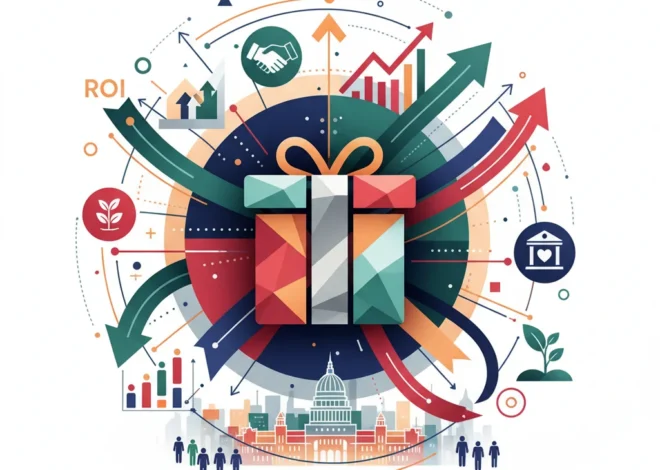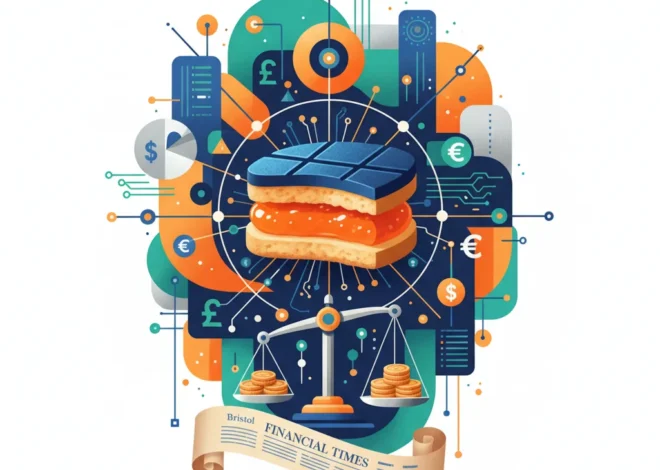The Baby Clothes Barometer: What a Small Charity Shop Reveals About the Future of Finance and the Global Economy
In the quiet town of Strabane, a new shop has opened its doors. It doesn’t trade in high-yield bonds or volatile tech stocks. Its inventory consists of tiny jumpers, miniature shoes, and soft onesies. Everything is free. This establishment offers free baby clothes for children up to the age of five, a simple act of community support for parents facing hardship. On the surface, it’s a heartwarming local news story. But for astute investors, finance professionals, and business leaders, it’s something more: a powerful, ground-level signal of profound shifts in our global economy and a glimpse into the future of value exchange.
While Wall Street and the City of London are fixated on macroeconomic indicators—inflation rates, GDP growth, and central bank policies—the real story of our economic health is often written in these small, community-driven initiatives. The emergence of a “baby bank” in a town in Northern Ireland isn’t an isolated act of charity. It is a microeconomic data point with macroeconomic implications, a real-world manifestation of the pressures shaping modern finance, investing, and the very fabric of our economic systems.
This article delves beyond the headline to analyze what this single shop represents. We will explore it as an unconventional economic indicator, a model for the burgeoning circular economy, and a catalyst for reimagining the role of financial technology in creating more resilient and equitable systems. What can a baby clothes shop teach us about the future of fintech, blockchain, and the stock market? As it turns out, quite a lot.
The Canary in the Coal Mine: Community Aid as a Macroeconomic Barometer
The primary driver for an initiative like the Strabane baby shop is, of course, economic hardship. For decades, economists have relied on traditional metrics to gauge the health of the economy. However, these broad statistics can often mask the lived reality of millions. The need for free essential goods for children points to a deeper malaise that isn’t always captured in quarterly earnings reports or stock market indices.
This phenomenon reflects several converging economic pressures:
- Persistent Inflation: While headline inflation may be moderating in some regions, the cumulative effect of price increases over the past few years has permanently raised the cost of living. The cost of essential goods, from food to children’s clothing, has outpaced wage growth for many families, stretching household budgets to their breaking point. According to a 2024 report by the Joseph Rowntree Foundation, 14.4 million people in the UK were in poverty in 2021/22, including 4.2 million children.
- Wage Stagnation: In real terms, wages for many in the lower and middle-income brackets have failed to keep up with productivity and living costs for over a decade. This long-term trend means that families have less of a financial cushion to absorb economic shocks, making them more reliant on community support.
- Gaps in Social Safety Nets: The rise of such grassroots organizations often signals that state-provided social safety nets are either insufficient or too difficult to access. These community-led initiatives step into the breach, creating a parallel, informal economy based on reciprocity and mutual aid rather than formal government transactions.
For investors and financial analysts, the proliferation of food banks, community closets, and “baby banks” should be considered a critical, qualitative dataset. It’s a leading indicator of consumer distress that may precede downturns in retail sales, increases in loan defaults, and reduced discretionary spending—all of which have direct impacts on the stock market and broader economic performance.
The £2.1 Billion Keyboard Stroke: How a Cyber Attack Became the UK's Costliest Financial Disaster
The Circular Economy and the Next Frontier of ESG Investing
The Strabane shop is more than just a response to hardship; it’s a functional example of the circular economy in action. By collecting, sorting, and redistributing pre-loved clothing, the initiative prevents waste, reduces consumption, and maximizes the lifecycle of goods. This model, born of necessity, mirrors a sophisticated economic concept that is rapidly gaining traction in boardrooms and among institutional investors: the circular economy.
The circular economy is a systemic approach to economic development designed to benefit businesses, society, and the environment. In contrast to the traditional ‘take-make-waste’ linear model, a circular economy is regenerative by design. This is precisely where the worlds of community aid and high finance intersect, through the lens of Environmental, Social, and Governance (ESG) investing.
Investors are increasingly aware that companies with strong ESG credentials and sustainable business models may be better positioned for long-term growth. A business that embraces circular principles can reduce input costs, mitigate supply chain risks, and enhance its brand reputation. The baby clothes shop, in its own small way, embodies the “S” (Social) and “E” (Environmental) of ESG.
The table below contrasts traditional financial metrics with the emerging metrics of this new economic paradigm:
| Traditional Economic Model | Circular & Social Economy Model |
|---|---|
| Core Goal: Profit Maximization | Core Goal: Value Optimization (Financial, Social, Environmental) |
| Value Metric: Shareholder Return (EPS, ROI) | Value Metric: Stakeholder Return (Impact Metrics, Waste Reduction) |
| Resource Model: Linear (Take-Make-Waste) | Resource Model: Circular (Reduce-Reuse-Recycle-Regenerate) |
| Investment Focus: High-growth, high-margin sectors | Investment Focus: ESG compliance, sustainable infrastructure, social impact |
| Relevant Keywords: Trading, Stock Market, Profit | Relevant Keywords: Investing, Economy, Sustainability |
The challenge for the finance industry is how to quantify and invest in the principles demonstrated by the Strabane shop. This is leading to the development of new financial instruments, like social impact bonds and funds dedicated to circular economy businesses, signaling a maturation of the ESG investing landscape.
Scaling Social Impact with Financial Technology (Fintech)
A single shop can help dozens of families. But how can we scale this impact to help millions? This is where financial technology can serve as a revolutionary force multiplier, taking the core principles of community aid and amplifying them on a global scale.
The current banking and finance infrastructure is not built to handle the small, often non-monetary transactions that define the social economy. Fintech, however, thrives on disintermediation and creating new, more efficient markets. Imagine applying the disruptive power of fintech and blockchain to the problem the Strabane shop is solving.
Here are three conceptual models:
- Decentralized Aid Platforms (De-Aid): Using blockchain technology, one could create a transparent, peer-to-peer platform connecting donors with those in need. A parent could post an anonymized request for “winter coat, age 4.” A donor could fund that specific need with a micro-transaction, and the blockchain would provide an immutable record of the entire process. This removes administrative overhead, reduces fraud, and ensures 100% of the value reaches the intended target. A World Economic Forum article highlights blockchain’s potential to create transparent and efficient systems for social good.
- Tokenization of Social Capital: What if the time spent volunteering at the shop, or the act of donating a bag of clothes, could be “tokenized”? These tokens, representing social contribution, could then be redeemed for community benefits, local business discounts, or even serve as a form of reputational collateral. This creates a formal system of value for activities that the traditional economy ignores, incentivizing community participation.
- AI-Powered Supply Chain for Good: Fintech isn’t just about finance; it’s about data. An AI-driven platform could optimize the collection and distribution of donated goods on a city or national scale. It could predict demand (e.g., a cold snap will increase demand for coats), optimize logistics for donation pickups, and ensure that resources are allocated to the areas of greatest need, transforming a network of local charities into a hyper-efficient national supply chain.
The table below summarizes how financial technology could enhance the community aid model:
| Challenge | Community Model Solution | Fintech/Blockchain Scaled Solution |
|---|---|---|
| Trust & Transparency | Local reputation, face-to-face interaction | Immutable ledger (blockchain) for tracking donations |
| Scale & Reach | Limited to a single town or neighborhood | Global digital platform connecting millions of users |
| Efficiency & Logistics | Manual sorting, volunteer-based | AI-optimized logistics, predictive demand analysis |
| Value Recognition | Informal social goodwill | Tokenization of volunteer hours and donations |
The £2.1 Billion Breach: How the Jaguar Land Rover Hack Rewrote the Rules of Financial Risk
This isn’t science fiction. The core technologies—blockchain, AI, mobile payment platforms—already exist. The next wave of fintech innovation may not be another high-frequency trading algorithm or a new crypto coin, but the application of these powerful tools to solve fundamental human problems.
A New Paradigm for Banking and Economics
The existence of a thriving, non-monetary economy based on mutual aid presents a fundamental challenge to the traditional models of banking and economics. Our current system is predicated on debt, credit, and interest-based transactions. The Strabane shop operates entirely outside of this framework. It’s a system of “asset” transfer with no corresponding “liability.”
This doesn’t mean traditional banking is obsolete, but it suggests its limitations. For finance professionals, it raises critical questions:
- How can banks support these community economies? Could they offer logistical support, provide spaces, or create special accounts for non-profits at no cost?
- What financial products can be developed for those operating partially outside the formal economy?
- As an indicator of systemic risk, how can the financial sector use the data from these initiatives to build more resilient and inclusive economic models?
The study of economics may also need to evolve. For too long, it has focused on rational actors in a monetized marketplace. The powerful drivers of community, reciprocity, and altruism, as demonstrated in Strabane, are often relegated to the “soft” social sciences. Yet, they are clearly potent economic forces. A future-proofed understanding of the economy must account for these parallel systems of value exchange.
Conclusion: From Strabane to the Stock Market
A small shop offering free baby clothes in Strabane is more than a heartwarming story. It is a microcosm of a global economic transformation. It serves as a real-time indicator of the pressures on modern families, a working model of the circular economy, and a canvas on which we can project the future of financial technology.
For the business leaders, investors, and finance professionals of today, the lesson is clear. The most significant opportunities and the most profound risks are not always found in the financial statements of the FTSE 100 or the S&P 500. They are found in the subtle shifts in how communities organize themselves to meet their needs.
By understanding the “why” behind this small shop, we gain a clearer understanding of the future of the global economy. The next unicorn startup in fintech might not be one that shaves milliseconds off a trade, but one that figures out how to scale the compassion and efficiency of the Strabane baby clothes shop to a global level. That is an investment worth watching.


